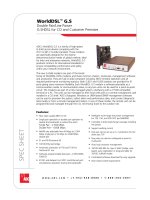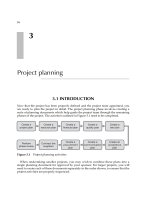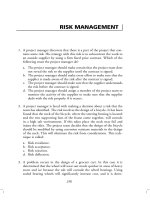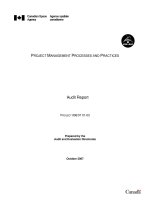Project Management Risk and Customer Relationship_11 docx
Bạn đang xem bản rút gọn của tài liệu. Xem và tải ngay bản đầy đủ của tài liệu tại đây (141.86 KB, 23 trang )
opportunities by industry, 6
profile creation of, 273, 274–275
Auditing and scoring outside,
155
–
161
B
Back-end validation, 176–177
Backward regression, 103, 105, 109–110, 112, 221, 222, 245, 268
Bad data,
175
Balance bombs, 201
Bayes' Theorem, 121
Behavioral data, 26, 27
Bootstrapping,
138
,
140
–
146,
147
,
148
adjusting, 146
analysis, 229
churn modeling and, 270, 271, 272–273
formula for, 140
jackknifing versus,
138
validation using, 138, 140–146, 147, 148, 224, 225, 227–230, 249, 251, 270
Branding on the Web, 316–317
Business builders customers, 201
Business intelligence infrastructure,
33
C
Categorical variables, 69–70, 80–85, 218–220
churn modeling and, 265, 266–268
linear predictors development and, 95–97
Champion versus challenger,
166
–
167,
175
Chi-square statistic, 78, 247
backward regression and, 105
categorical variables and, 80, 82, 83, 85, 218–219
continuous variables and,
210
–
211
forward selection method and, 104
score selection method and, 105
Page 360
(continued)
Chi-square statistic
stepwise regression and, 105
variable reduction and,
77
,
78
,
79
Churn, 10.
See also Modeling churn (retaining profitable customers)
case example of, 42
definition of,
11
Classification trees,
19
–
20
example of, 19
goal of, 19
interaction detection using, 98
linear regression versus,
19
purpose of, 19
software for building, 98
Classifying data, 54–55
qualitative,
54
quantitative, 54
Cleaning the data, 60–70, 188
categorical variables, 69–70
continuous variables, 60–69
missing values,
64
–
69
outliers and data errors, 60, 62–64
Web and, 309
Cluster analysis, 184
example,
205
–
206
performing to discover customer segments, 203–204, 205–206
Collaborative filtering on the Web, 313–316
ad targeting, 315
applications in near future,
315
call centers, 315
e-commerce, 315
of information, 313
knowledge management and, 314
managing personal resources,
316
marketing campaigns, 315
trend in evolution of, 314
workings of,
9–10
Combining data from multiple offers, 47–48
Computers
logistic models and, 4
Constructing modeling data set, 44–48
combining data from multiple offers, 47–48
developing models from modeled data,
47
sample size, 44–45
sampling methods, 45–47
Consummate consumers, 201
Continuous data, 54–55
Continuous variables,
76
–
79,
157
,
210
–
218,
236
churn modeling and, 263–265, 266
means analysis of, 212
transformation of, 215–216, 267
Cookie,
308
Cooking demonstration, 49–180
implementing and maintaining model, 151–180
preparing data for modeling, 51–70
processing and evaluating model,
101
–
124
selecting and transforming variables, 71–99
validating model, 125–150
Creating modeling data set, 57–59
sampling, 58–59
Credit bureaus,
3
Credit scoring and risk modeling, 232–233
Cross-sell model, 10
case example of, 41
opportunities for, 6, 41
Customer, understanding your,
183
–
206
cluster analysis performing to discover customer segments, 203–204, 205–206
developing customer value matrix for credit card company, 198–203
importance of, 184–189
market segmentation keys,
186
–
189
profiling and penetration analysis of catalog company's customers, 190–198
summary of, 204
types of profiling and segmentation, 184–186
value analysis,
109
–
203
Customer acquisition modeling examples, 37–40
Page 361
Customer database components, 28–29
Customer focus versus product focus, 22–23
Customer insight gaining in real time, 317–318
Customer loyalty,
258
Customer models, data for, 40–42
Customer profitability optimizing, 276–278
Customer relationship management (CRM), 284, 285, 286
Customer value matrix development, 198–203
D
Data
types of, 26–27
validation, 152–155
Data errors and outliers,
60
,
62
–
64,
69
Data marts, 31
Data mining software classification trees, 98
Data preparation for modeling. See Preparing data for modeling
Data requirements review and evaluation,
187
–
188
Data sources selecting, 25–48
constructing modeling data set, 44–48
for modeling, 36–44
sources of data, 27–36
summary of,
48
types of data, 26–27
Data warehouse, 31–35
definition of, 31
meta data role,
34
mistakes and best practices, 34–35
typical, 32, 45
Dates, 75–76
Decile analysis,
101
,
247
,
297
bootstrapping and, 140–141
calculating, 239
TEAMFLY
Team-Fly
®
creating,
113
,
116
–
117,
122
–
123
example, 249
file cut-off determination and, 166
gains table and, 149
on key variables, 146–150
of scored file,
164
using validation data, 118, 120, 121, 123
Decision tree. See Classification trees
Demographic data, 26
characteristics of,
27
Demographics and profile analysis, 7–8, 185–186
Descriptive models, 4, 5
Developing models from modeled data, 47
Duration and lifetime value modeling,
284
,
285
–
286
E
E-mail inquiry on response data, 308
Evaluating and processing the model. See Processing and evaluating the model
Exploratory data analysis, 175
External validity of model,
174
F
Factor analysis, 184
File cut-off determination, 166
Financials, calculating,
161
–
165
Focus on product versus customer, 22–23
Fraud, 253, 254–255
Frequency type of profiling, 185
G
Gains tables and charts, 125–129
creating, 126–127, 247
examples, 126, 129, 133, 138, 139, 145, 147, 149
lifetime value model and, 301, 302, 303, 304
NPV model,
165
for score comparison, 250
two model method and, 127–129
validation examples,
128
,
129
,
226
–
227,
271
,
272
Genetic algorithms, 17–18
example, 18
Goal defining, 4–12
activation,
10
Page 362
(continued)
Goal defining
attrition,
10
–
11
cross-sell and up-sell, 10
lifetime value, 11–12
net present value, 11
profile analysis,
7
–
8
response,
8
–
9
risk, 9–10
segmentation, 8
steps in, 5
H
High-risk customers, avoiding, 231–255. See also Modeling risk
Hiring and teamwork, 21–22
I
Implementing and maintaining the model,
151
–
180,
230
back-end validation, 176–177
calculating the financials, 161–165
champion versus challenger, 166–167
checking, 172
churn and,
273
–
278
determining file cut-off, 166
high-risk customer avoidance and, 251–253
maintenance, 177–179
scoring a new file,
151
–
161
summary of, 179–180
tracking, 170–177
two-model matrix, 167–170
Intelligence architecture of business,
33
Interactions detection, 98–99
Internal validity of model, 174
Interval data, 54
J
Jackknifing,
134
–
138,
139
L
Lifecycle of model, 175, 177–178
benchmarking, 177
rebuild or refresh, 177–178
Life stage as type of profiling,
186
Lifetime value model, 4, 6, 11–12, 281–304. See also Modeling lifetime value
Lift measurement, 127, 136, 137, 141, 143, 224, 225, 226
Linear predictors development, 85–97
categorical variables,
95
–
97
continuous variables, 85–95
Linear regression analysis, 12–14, 208, 209, 295
examples, 13, 14
logistic regression versus,
15
,
16
net revenues and,
292
neural networks versus, 16
List compilers, 36, 41
List fatigue, 173–174
List sellers,
36
,
41
Logistic regression, 3–4, 12, 15, 16, 295, 296
categorical variables and, 95, 218
continuous variables and, 85, 86, 93
example,
15
,
223
formula for, 16
jackknifing and,
135
linear regression versus, 15, 16, 85
processing the model and, 102, 221, 222, 245, 246
variable selection using,
240
–
241
LTV. See Lifetime value model
M
Mail tracking, 171
Maintaining and implementing the model, 151–180. See also Implementing and maintaining the model
Maintenance of model,
177
–
179
model life, 177–178
model log, 178–179
Market or population changes, 152, 153–154, 155
MC.
See
Multicollinearity
Meta data, 31
role of, 34
types of, 34
Page 363
Methodology, choosing modeling, 12–20
classification trees, 19–20
genetic algorithms, 17–18
linear regression,
12
–
14
logistic regression, 15–16
neural networks, 16–17
Missing values, 64–69
class mean substitution,
65
–
67
regression substitution,
67
–
69
single value substitution, 64–65
Model log, 178–179
Model tracking, 170–177
Modeling churn (retaining profitable customers),
257
–
279
bootstrapping, 271, 272–273, 274
categorical variables, 265, 266, 267–268
continuous variables, 263–265, 266, 267
customer loyalty,
258
implementing the model, 273, 274–278
objective defining, 258–263
optimizing customer profitability, 276–278
preparing variables, 263–268
processing the model,
268
–
270
retaining customers proactively, 278
summary of, 278–279
validating the model, 270, 271–273, 274
Modeling lifetime value (targeting profitable customers),
281
–
304
applications of, 286–289
business-to-business marketing, 286–288
calculating for renewable product or service, 290
calculation,
298
,
299
–
303,
304
case studies, 286–289
case study calculation, 290–303
components of,
284
definition of, 282–286
duration assigning, 284–286
duration designing and, 284–286
insurance marketing opportunities and, 291
marketing decisions and,
283
summary of, 303, 304
uses of, 282
Modeling response (targeting new prospects), 207–230. See also Targeting new prospects
Modeling risk (avoiding high
-
risk customers),
231
–
255
bootstrapping, 249, 251
credit scoring and, 232–233
fraud, 253, 254–255
implementing the model,
251
–
253,
254
objective defining, 234–235
preparing variables, 235–244
processing the model, 244–248, 249
scaling the risk score, 252–253, 254
summary of,
255
validating the model, 248, 249–251
Modeling on the Web, 305–322. See also Web modeling
Models going bad from good, 170–175
Monetary value type of profiling,
185
Multicollinearity, 106–108
Multiple regression (MR) analysis, 106
N
Net present value model
calculation for single product of, 162
components of, 71–74, 161–162
definition of, 161
file cut-off determination and, 166
gains table,
165
goal defining and, 11
lifetime value modeling and, 281, 290, 291
opportunities by industry and,
6
predicting, 71
product profitability and, 163, 165
risk component of, 72, 73
Neural networks,
16
–
17
linear regression versus, 16, 17
sample diagram of, 17
Nominal data,
54
NPV.
See
Net present value model
O
Objective, setting. See Setting the objective
Page 364
Objective function, defining, 71–74
marketing expense, 74
probability of activation, 72–73
product profitability,
73
risk index, 73
Objectives, defining, 187, 207–210, 234–235, 258–263
Offer history database, 30–31
Opportunities by industry targeting model, 6
Ordinal data,
54
Ordinary least-square regression (OLS), 106
Outliers and data errors, 60, 62–64
P
Penetration analysis,
193
,
194
–
198
Planning the menu, 1–48
considerations for, 2
selecting data sources, 25–48
setting the objective,
3
–
24
Population or market changes, 152, 153–154, 155
Predictive models, 4, 5, 207
Preparing data for modeling, 51–70
accessing the data, 51–54
classifying data,
54
–
55
cleaning the data, 60–70
creating modeling data set, 57–59
reading raw data, 55–57
summary of,
70
Web, 309–310
Preparing variables, 235–244, 263–268
Probability of activation, 72–73
PROC UNIVARIATE procedure,
60
,
157
,
225
decile identifiers and, 115, 239
outliers and, 63–64
segmentation and,
88
Processing and evaluating the model, 101–124
backward regression, 103, 105, 109–110
comparing methods, 121–123
one model method, 108–114, 115–119
preliminary evaluation,
117
–
119
score selection method, 103, 105, 110, 111, 112
splitting the data, 103–104, 105, 108
stepwise regression, 103, 105, 109, 110, 111
summary of,
124
two models method, 119–121
Processing the model, 221–224, 225, 226–227, 244–248, 249, 268–270
Product focus versus customer focus, 22–23
Product profitability,
72
,
73
Profile analysis, 7–8
Profiling
definition, 184
types of, 184–186
Profiling and segmentation of customer.
See
Customer, understanding your
Profitable customers, retaining. See Modeling churn
Profitable customers, targeting. See Modeling lifetime value
Propensity model, 208
Prospect data,
37
–
40
case examples for, 38–40
Psychographic data, 26–27
characteristics of, 27
Q
Quantitative data, 54–55
R
Ratios, 75
Reading raw data, 55–57
Rebuild versus refresh a model,
177
–
178
TEAMFLY
Team-Fly
®
Recency type of profiling, 185
Recipes for every occasion, 181–322
avoiding high
-
risk customers,
231
–
255
modeling churn, 257–279
modeling lifetime value, 281–304
modeling response, 207–230
modeling risk,
231
–
255
modeling on the Web, 305–322
profiling and segmentation, 183–206
retaining profitable customers, 257–279
Page 365
targeting new prospects, 207–230
targeting profitable customers, 281–304
understanding your customer, 183–206
Referrer log,
308
,
309
Resampling, 134–146
bootstrapping, 138, 140–146
jackknifing,
134–138, 139
usage methods, 134
Response model,
8
–
9,
207
,
208
,
230
Retaining customers proactively, 278
Retaining profitable customers (modeling churn), 27–279
Retention modeling.
See also
Modeling churn
advantage of, 258
case example, 42
RFM (recency, frequency, monetary) value analysis, 23, 185, 190–193, 194
Risk index,
72
,
73
,
162
Risk matrix example, 73
Risk model(s), 9–10, 231–255.
See also Modeling risk
banking industry and, 9
case examples of,
43
–
44
financial type, 42
fraud and, 10
insurance industry and, 9
selecting data for,
42
–
44
Risk score, scaling, 252–254
Risky revenue customers, 201
Rotate your lists, 173–174
R
-
square,
13
genetic algorithms using, 18
S
Sample size, 44–45
Sampling methods, 45–47, 58–59, 188
Scoring alternate data sets,
130
–
134,
221
Scoring a new file, 151–161
data validation, 152–155
in-house, 152–155
outside scoring and auditing, 155–161
Segmentation
analysis example, 214
definition, 184
keys to, 186–189
method for,
188
rules for testing, 189
team for, 187
types of, 184–186
Segmentation and profiling of customer, 7–8. See also Customer, understanding your
Selecting and transforming variables,
71
–
99
categorical variables, 80–85
defining objective function, 71–74
deriving variables, 74–76
developing linear predictors,
85
–
97
interactions detection, 98–99
summary of, 99
variable reduction, 76–79
Selecting data for modeling,
36
–
44
for customer models, 40–42
prospect data, 37–40
for risk models, 42–44
Selecting data sources. See Data sources selecting
Selection criteria, different,
152
,
154
Selection methods for variables entered/removed, 104, 105
Server logs, 307–308
Setting the objective, 3–24
adaptive company, 20–23
goal defining,
4
–
12
methodology, choosing modeling, 12–20
questions to ask for, 5, 6–7
summary of, 23–24
Solicitation mail,
31
Sources of data, 27–36.
See also Data sources selecting
customer database, 28–29
data warehouse,
31
–
35
external, 36
internal, 27–35
offer history database, 30–31
solicitation mail or phone types, 31
transaction database,
29
variation in, 153, 155
Page 366
Splitting the data, 103–104, 105, 108, 198, 199
Stepwise regression, 103, 105, 109, 110, 111, 215, 221, 222, 245, 268
Stratified sampling,
46
Summarization, 74–75
T
Target marketing, 3
categories of,
4
opportunities by industry,
6
steps for, 5
Targeting model purpose, 130
Targeting new prospects, 207–230
defining the objective,
207
–
210
implementing the model, 230
preparing variables, 210–220
summary of, 230
validation using bootstrapping,
224
,
225
,
227
–
230
Targeting profitable customers, 281–304. See also Modeling lifetime value
Telephone checking, 171
Transaction database, 29
Transforming and selecting variables. See Selecting and transforming variables
Troubleshooting tips,
171
–
175
Two-model matrix, 167–170
U
Understanding your customer. See Customer, understanding your
Up
-
sell models,
10
case example for, 41–42
opportunities for, 6, 41
V
Validating the model,
125
–
150,
248
,
249
–
251
bootstrapping, 138, 140–146, 147, 148, 224, 225, 227–230, 249, 251, 270
churn, 270, 271–273, 274
decile analysis on key variables, 146–150
external, 174
gains tables and charts,
125
–
129
internal, 174
jackknifing,
134–138, 139
resampling, 134–146
scoring alternate data sets,
130
–
134
summary of, 150
Validation
backend, 176–177
data sets,
103
using bootstrapping, 224, 225, 227–230, 270, 271, 272–273
Value matrix development, customer, 198–203
Variable reduction, 76–79
Variables, categorical, 69–70, 80–85, 218–220
churn modeling and,
265
,
266
–
268
linear predictors development and, 95–97
Variables, continuous, 76–79, 157, 210–218, 236
churn modeling and, 263–265, 266
cleaning,
60
–
69
linear predictors development and, 85–95
preparing, 210–220
segmentation, 88–89, 90–92
transformations, 89, 93–95
Variables, deriving,
74
–
76
dates, 75–76
preparing, 235–244
ratios, 75
summarization,
74
–
75
Variables, selecting and transforming. See Selecting and transforming the variables
Variables, what is right number of, 114
W
Web modeling, 305–322
analyses, 312
association rules,
311
branding on the Web, 316–317
case study (credit card), 306–307
case study (Web usage mining), 318–322
Page 367
clustering, 311–312
collaborative filtering, 313–316
cookie, 308
e
-
mail inquiry or response data,
308
form or user registration, 308
gaining customer insight in real time, 317–318
measurements to evaluate web usage, 318–320
objective defining,
306
–
307
path analysis, 310–311
predictive modeling and classification analyses, 312
preparing Web data, 309–310
selecting methodology, 310–316
sequential patterns,
311
server logs, 307–308
sources of Web data, 307–309
statistics on Web site visits, 320
summary of,
322
transaction types, 310
Web mining versus, 306
Web purchase data, 308–309
Web sites
as behavioral data, 26
direct mail versus, 9
troubleshooting, 171, 172









